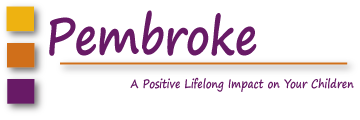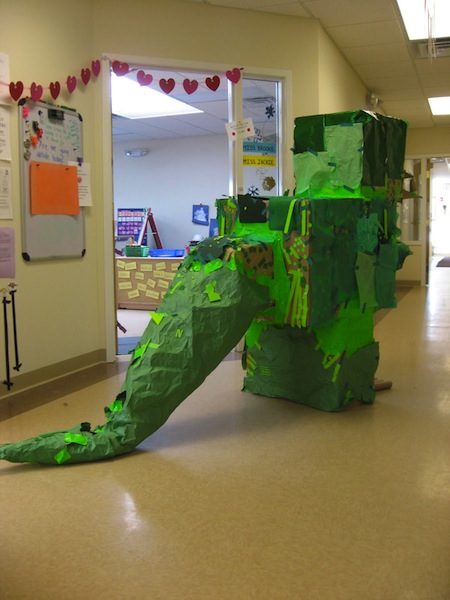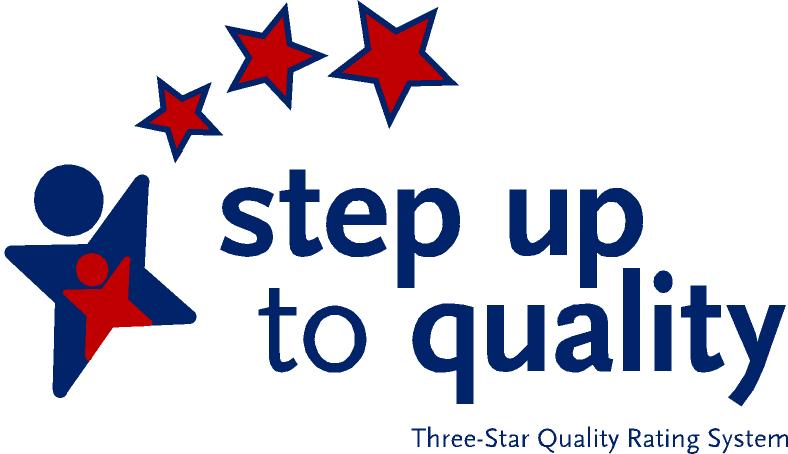This past week, we finished up our much beloved dinosaur unit! We spent the final week working on a very special dinosaur building project. We began the week by learning the different characteristics and habits of meat-eating and plant-eating dinosaurs. We used many picture books to aid in our research. We also learned some new vocabulary such as “carnivores” and “herbivores”. After taking a vote, we decided to try to build a carnivore. With a few boxes, some coffee canisters, lots of paper tubes, four rolls of tape, and a little imagination from our friends, we managed to build our giant meat-eater. Our friends decided that in order for our dinosaur to be a true carnivore, he needed to have a big head, strong jaw, sharp teeth, short arms (with two claws each), two big legs (with three toes each), and a long tail. After figuring out how to add the final features to our dinosaur, they worked very hard to cover him from head to toe in green collage material (with the help of a few more rolls of tape, of course!). This was a huge hit! The children absolutely loved sticking on the different textures and materials to the dinosaur. Finally, we came up with some ideas for naming our dinosaur. After a close vote, it was decided that our dinosaur would be named Meat-Eater. The children made a sign for him and we hung it from the ceiling above him.
Building our dinosaur, we covered many state standards along the way. Many of these standards were science-related. We recognized physical differences between carnivores and herbivores. We explored and identified parts of dinosaurs. We even explored new uses for familiar objects (like coffee canisters and paper tubes) through art as well as demonstrated safe use of tools (like scissors). We also covered many language arts standards too. We acquired new vocabulary. We used a variety of resources to gather information about dinosaurs and then shared our findings through a form of media. Finally, when making the name sign, children also began to determine a purpose for writing as well as gained practice in printing letters.
These next two weeks we will begin learning about the grocery store and the food pyramid. A big part of this unit will be our “I Can Read!” project. This project will focus on environmental print, or the print of everyday life. Environmental print is the everyday print children have concrete connections to and can “read” with comfort. Environmental print can often be found on various labels or in the form of logos. It often can be found on familiar foods (such as McDonald’s, Cheerios, Skittles, or Juicey Juice) or familiar toys and tags (such as Xbox, Barbie, or the Cleveland Cavaliers). If you would like to help with this project, please save and cut out labels or logos of environmental print that your child is familiar with and send them in. (We will be collecting them from now until the end of the year.) We will be creating “I Can Read” posters and using these for various games. Children will also use these posters to practice “reading” words. Through these environmental print posters, children will gain confidence and feel success in reading, gain letter awareness, and gain exposure to different types of letter fonts. They will also begin to distinguish print from pictures and recognize that print has meaning. These all are essential components in early reading foundations. If you would like to extend this project at home, try having your child “read” signs and labels to you as you are taking a ride in the car, shopping in a store, or cooking a meal at home. (Can they “read” words like Bob Evans, Super K, or Pop Tarts? They may surprise you!) And don’t forget to send in those labels and logos!!!



Leave A Comment